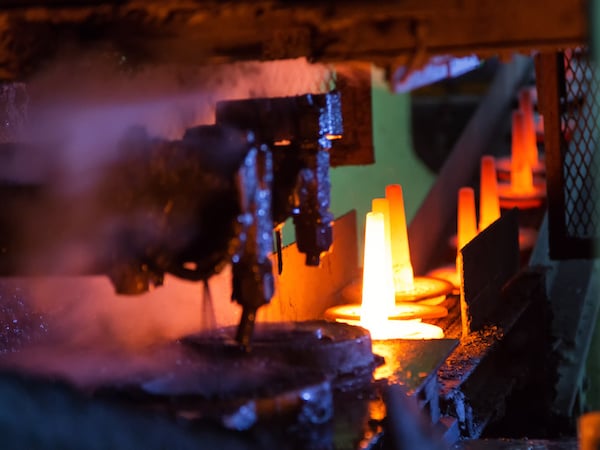Along with the location of the cultural history of man, forging metals began with the Sumerians in the land between the Tigris and the Euphrates rivers in Mesopotamia, dating back to around 4500 B.C.
Beginning in the Middle East, the forming of metals by forging eventually spread throughout Europe and Asia. By first forming metals such as gold, silver and copper by heating them to high temperatures, people were able to form a variety of simple shapes. By the next few millennia, about 1500 BC, the Hittites of Anatolia began blacksmithing when they discovered smelting. From that, the Iron Age was born. Therefore, about 3500 years ago our ancestors began to forge shapes. Though the Bronze Age was thousands of years earlier, it quickly became the metal of choice to forge weapons and hand tools. However, since iron was more plentiful it became the next metal of choice for forging. 
Fast forward to today when many things we use are made by forging, from hand tools to surgical instruments, to fittings and valves. The forging process can make small parts of a few ounces to large components up to 350 tons.
Metals used for manufacturing hydraulic fittings and adapters include coated carbon steel used in demanding applications; stainless steel where the external environment or internal media is highly corrosive; and brass, which is often used in lower pressure applications.
The most durable fittings are manufactured by a forging process made from one piece of metal and machined to the required specifications, as opposed to casting where liquid metal is poured into a mold of the intended shape; or brazing where multiple machined components are bonded together. Because forged fittings are made from one piece of metal, they are manufactured with less material, providing a more compact design and a smaller wrench flat. Most importantly, the single body construction of a forged fitting makes them much stronger than a brazed joint or casted product, allowing for higher pressure ratings and a longer service life.
Fittings made in a casting process where molten metal is poured into a mold does not have the ductility and overall durability of a forged fitting. However, in low quantities casting can be more cost effective, but the final product will not have the durability of forging. Forged steel fittings are more reliable and much stronger than castings because the forging die alters the grain flow of a solid steel piece to form it into the specified shape.
Like Fittings, Forged Valves are the Better Choice
Many types of valves are forged for the same reasons as fittings, such as high strength, the ability to withstand higher pressures and longer service life. Also, like fittings, forging valve bodies minimize wasted material, can withstand high temperatures with minimal porosity/shrinkage and are less likely to experience cracks, compared to casting and other processes.
Again, like fittings, forged valves are much better suited for oil and gas, nuclear, aerospace and power generation applications. The thermal fatigue reduction in the forging process is a chief benefit of forged valves, because if they have a thinner wall structure rapid heating or cooling will not be detrimental to the final product’s functionality.
High Pressure Forged Fittings and Valves
High pressure forged fittings and valves is the solution to industrial parts, heavy equipment components and virtually any demanding application. Forged fittings and valves are used in applications where high performance is expected. Their intricate shapes make it nearly impossible to manufacture these parts using other processes. The process of high-pressure forging, which usually places many thousand pounds per square inch on blank metal parts, creating a final product that can withstand extreme applications. This forging process for fittings and valves provides a high strength-to-weight ratio and reduces the amount of metal needed to produce the finished part. It gives the component outstanding performance and an increased service life under extreme conditions, such as high temperatures, high pressures and corrosive fluids.
Conclusion
The strength and reliability of the forged metalworking process ensures superior strength and durability that is an effect of its tight grain structure. Forged components provide reliability, strength and ductility that casted, brazed, fabricated and machined products cannot.
The forging process also has substantial cost advantages in precision metal manufacturing, particularly with high volume production that requires fewer secondary operations. And one of the primary advantages of machine forging is it can be applied to virtually any type of metal. Different metals, such as stainless steel, carbon steel and brass have their own distinct set of metallurgical characteristics that when forged provide highly dependable finished product.

